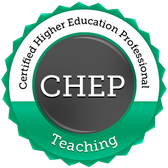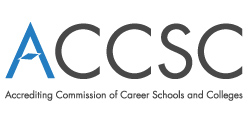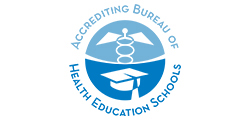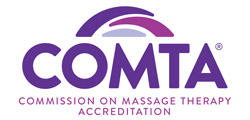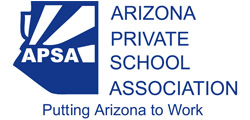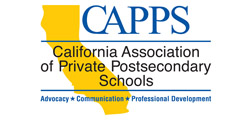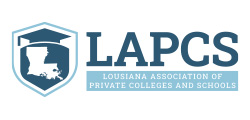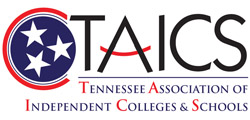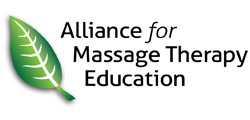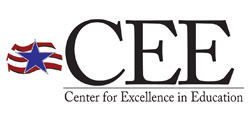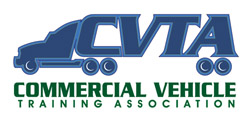Badge Evidence | Completed Courses (4 Hours Each)
ABHES101Developing a Program Effectiveness Plan (PEP)
The health care field is growing rapidly, as are the requirements for preparing individuals to enter and be successful in their chosen health care fields. To remain current with the demands of career preparation areas, colleges and universities need to have a plan of action to assess the status of programs and strategies for improving instructional offerings. This course will provide participants with a step-by-step process to complete an internal program quality assessment tool called the Program Effectiveness Plan (PEP). Resources are provided that will expand the knowledge base of participants and assist them in completing a PEP.
This course is sponsored by
Accrediting Bureau of Health Education Schools
Accrediting Bureau of Health Education Schools
EC131How to Develop Virtual Reality Lessons
Virtual reality (VR) lessons can be implemented in all subject areas, and this course is designed to get teachers thinking about how it can be used in their classrooms. VR can be a nice addition to the teaching toolkit, but some resources, including hardware, will be needed. In this course we use the Meta Quest 2 headset by Oculus, but the results will be similar if different headsets are used. Various software applications will be shared that teachers can acquire for little or no cost.
EC140Introduction to Positive Psychology for Educators
Positive psychology is the science of human flourishing and is leveraged to cultivate well-being for students, teachers, and staff in schools around the world. You'll be introduced to the tools of positive psychology to help you and your students thrive in the classroom and in life. This course is designed to help you understand the science of well-being and how to employ it for yourself and in educational settings to support well-being and academic achievement. The modules cover positive psychology's origins, and the research and application of the PERMA model, Character Strengths, and positive education.
EC153Strengthening CTE Instruction with Clear Learning Goals
This course, designed especially for CTE educators, explores the role that goals play in learning and how they are an important part of a CTE course. Simply put, learning goals give students a clear understanding of what they are expected to know and be able to do by the end of a learning experience or unit of study. When an instructor sets clear goals for their courses, or for a learning experience, students know where they’re headed. Just as a GPS lets travelers know where they will arrive at the end of their journey, a clear goal gives learners an understanding of what is expected of them.
Universal Design for Learning (UDL) is a framework to improve and optimize teaching and learning for all people based on scientific insights into how humans learn. When a CTE teacher designs instruction using the UDL framework, they start with a clear learning goal, consider the variability of learners in their course, predict what barriers learners might face when trying to meet the goal, and then, design their instruction to remove as many barriers as possible. When teachers approach instructional design using UDL, learning environments are more accessible, inclusive, equitable and challenging for every learner. And, these equitable learning environments all begin with clear learning goals! (CAST, The Goal of UDL)
ED101Effective Teaching Strategies
This introductory course covers the essential roles of a teacher and the competencies required to be a successful instructor in an educational institution. Proven techniques and strategies for planning and preparation are presented and discussed. In addition, the course offers effective methods for conducting the first class meeting and delivering course content. This course provides a solid foundation for new instructors and serves as an excellent refresher for more experienced instructors.
ED102Student Retention Methods
The instructor is the real key to student retention at any educational institution. Instructors must keep focused on student motivation and retention each and every day of class. Developing strategies for retaining students throughout the entire training sequence is both complex and rewarding. All instructors should have the goal of seeing all of their students successfully complete their class. This course helps you reach that goal by helping you to understand your students and use proven motivation and retention techniques to keep them enrolled and engaged in the learning process.
ED104Class Management Strategies
This course provides methods and techniques for managing students and class activities. We start by reviewing the steps instructors need to follow as they introduce a class to new students. We then discuss strategies to effectively deal with unfocused and challenging students. The course ends by describing common mistakes made by instructors and ways to avoid them.
ED110Time and Stress Management for Instructors
Outstanding teachers serve their students by guiding them through their coursework and motivating them to complete program requirements. Instructors at educational institutions are often faced with high stress resulting from heavy teaching loads and limited time. When teachers cannot manage their own time and stress, they cannot fully serve the needs of their students. This course will show instructors how to manage time and stress in their lives and teach some of these skills to their students.
ED112Influencing Student Motivation
This course is intended to offer a practical explanation of how an instructor’s behaviors and choices can influence the motivation of students. It is not intended to be a theoretical or academic treatise about motivation. Module 1 offers useful tips that may help instructors to motivate students. Students’ security and autonomy are described as they influence motivation during instruction, questioning, activities, and evaluations. This is followed by a discussion of how motivation can be improved by enhancing students' sense of autonomy when making assignments, selecting instructional methods, implementing classroom procedures, and developing evaluations. In Module 2, intrinsic and extrinsic motivators are defined and compared. Finally, a variety of "miscellaneous motivators" are offered for instructors to consider.
ED115RSoft Skills for Instructors
This survey course provides an introductory discussion about how good soft skills help instructors to be successful. A distinction is made between hard skills, soft skills, people skills, and workplace behaviors. Selected soft skills are listed for various categories of businesses and industries, including the teaching profession. Two studies are referenced that highlight skills that are frequently cited in the literature. One study was published in 1997, while the other was conducted specifically for this course in 2024. Selected tips are offered for improving one's soft skills. Numerous hyperlinks are included that direct the reader to a variety of online enrichment materials, including a few online instruments that help individuals learn more about their own soft skills.
ED116Critical Thinking Processes and Applications
The majority of careers require the ability to think critically and problem solve at one level or another. Employers seek individuals who can think independently, propose solutions, and solve problems. The content in this course provides the foundation for critical thinking and demonstrates how people with different interests, abilities, and aptitudes approach problem solving. The course covers the different kinds of intelligence and how they impact critical thinking, for a broader understanding of how people process solutions to problems. It concludes with step-by-step instructions for helping students develop and refine their own critical thinking skills.
ED139Emotional Intelligence in Learning
Emotional Intelligence (EI) is an increasingly important field of study. The purpose of this course is to explore the relevancy of emotional intelligence in learning; and how understanding the importance of emotional intelligence supports student success. While instructors are more aware now of the various forms of intelligence, emotional intelligence has been undervalued in the past as a vital form of intelligence. Indeed, emotionally intelligent students may provide insight and application of knowledge in new and informative ways which can have positive impact on their learning progression and success.
ED311Creative Teaching Tools in Clinical and Didactic Courses
Have you ever wondered how to make your health classes more "real" world? In this course, you will learn ways to get students thinking in terms of successfully applying their skills in the workplace. Utilize instructional tools and actual sample methods for teaching critical thinking in both the clinical and didactic learning environments, and share ideas that have worked for you.
EL101Designing and Developing Online Courses
This introductory course will provide you with the knowledge and skills to create successful online courses, whether for faculty-supported distance education delivery or as a supplement to classroom instruction. You will learn to design and develop online courses that have structural integrity and navigational simplicity with a focus on student-centered learning and intellectual interaction. The course covers various learning activities that are supported in an e-learning environment and describes the typical components of an online course. We will provide you with the media strategies and course design methodologies that will allow you to develop online courses in an effective and efficient manner.
EL102Online Teaching Techniques
Your degree of success as an online instructor relies heavily on several factors, among which are your level of preparedness before the date on which the course is launched; your ability to make a smooth transition into the roles and responsibilities associated with teaching in an online environment; and the effectiveness and efficiency with which you manage learners, instructional transactions embedded in the course as well as the learning environment. In this course, you will learn how to project your authority and presence into the e-learning environment, build a relationship with each learner, promote and nurture learner participation, provide informative and constructive feedback in a timely manner, minimize attrition, manage communications, manage unacceptable behavior and resolve disagreements.
EL105ROnline Language: Communicating with Students
This course provides information to help you effectively communicate with students and encourage communication among students in an online environment. You will learn the importance of facilitating instructor-to-student (I2S), student-to-instructor (S2I), and student-to-student (S2S) communication. Digital technology tools play a vital role in the modern communication process, and several are discussed in this course. In addition, discussion is provided to help you further understand how to manage and measure communication in an online course and help students communicate effectively.
EL106Evaluating Student Learning in Online Courses
This course will provide you with the knowledge to effectively evaluate student learning in an online environment. Technology tools play a vital role in the evaluation process and several are discussed in this module. Discussion will also be provided to help you further understand how to complete formative and summative assessments, as well as the advantages and disadvantages of objective and subjective assessments. Value-added assessments are also discussed in light of how they can be completed and provide feedback for course revision.
EL107RDesigning Dynamic and Technology-Rich Learning Environments
This course outlines the main characteristics of "dynamic" course design for blended instruction and highlights effective teaching methods that facilitate the learning process. Participants in this course will be able to customize the design principles and methods presented here to suit their individual professional context.
EL108Preparing Students to Become Good Online Learners
This course will provide you with strategies and techniques to help prepare students for the online environment. To do so, you must also assess your strengths and weaknesses as an online instructor. As you help students assess their readiness for online learning, you are also preparing them for the expectations and realities of the online environment. By identifying students' strengths and weaknesses, you can provide guidance to help them achieve the learning outcomes. This course not only notes the necessary technical skills, it also discusses non-technical skills as well as techniques for successful learning and helping students develop their online persona.
EL112Workload Management Strategies for Teaching Online
This course will provide you with strategies and techniques to help you reduce your workload in the online environment. The course begins with an overview of good principles for education and questions to consider prior to developing Workload Management Strategies (WLMS). This course also provides WLMS for teaching online, communicating and collaborating, and revising your online course.
EL113Active Learning in an Online Environment
This course will provide you with a basic overview of the background and history of the popular instructional method called active learning. This method differs from traditional educational methods such as the lecture model. Active learning has a definite place in education especially in the online learning environments. It is used to support teaching outcomes like critical thinking skills, interpersonal skills and knowledge acquisition that all instructors wish for their students. However, active learning it calls for a change of attitude on the part of students and the instructor in order to be successful. But the advantages far outweigh the disadvantages as it can make students enthusiastic about learning. Learn about this brave new world of teaching and learning for the next generation.
EL116The Asynchronous, Self-Directed Learning Model
This course will provide you with a basic overview of designing and implementing asynchronous, self-directed online courses effectively. It will review the differences between synchronous and asynchronous online courses. Traditional components of face-to-face courses such as readings, written assignments, and discussions work well in the asynchronous online class environment, but what happens to laboratory assignments and applications? Can they fit into the online course model? Courses which need a lab component, especially the STEM (Science, Technology, Engineering, and Math) courses, may seem impossible to complete in the online environment. Practical examples of effective online lab situations will be provided in this module. This will assist in promoting student engagement and increasing the student's learning potential.
EL117Understanding Personality Traits of Online Instructors and Learners
This course will provide you with an overview of online instructors' and learners' personality traits. Participants will be provided with information about the traits themselves, as well as how to identify such traits, utilize them, and develop lessons to reach all students.
EL120Fully Online Doesn't Mean Inactive
Active and passive learning are critical concepts to ponder for online learning. Each one has positive benefits when explored and applied in the context of learning and the designing of instruction. There is, however, a difference between passive and inactive. One is an intentional part of learning while the other is the absence of something. We will explore these and other concepts in this course. In addition, strategies will be shared that will enable educators to make their online instruction more engaging and beneficial for learners.
